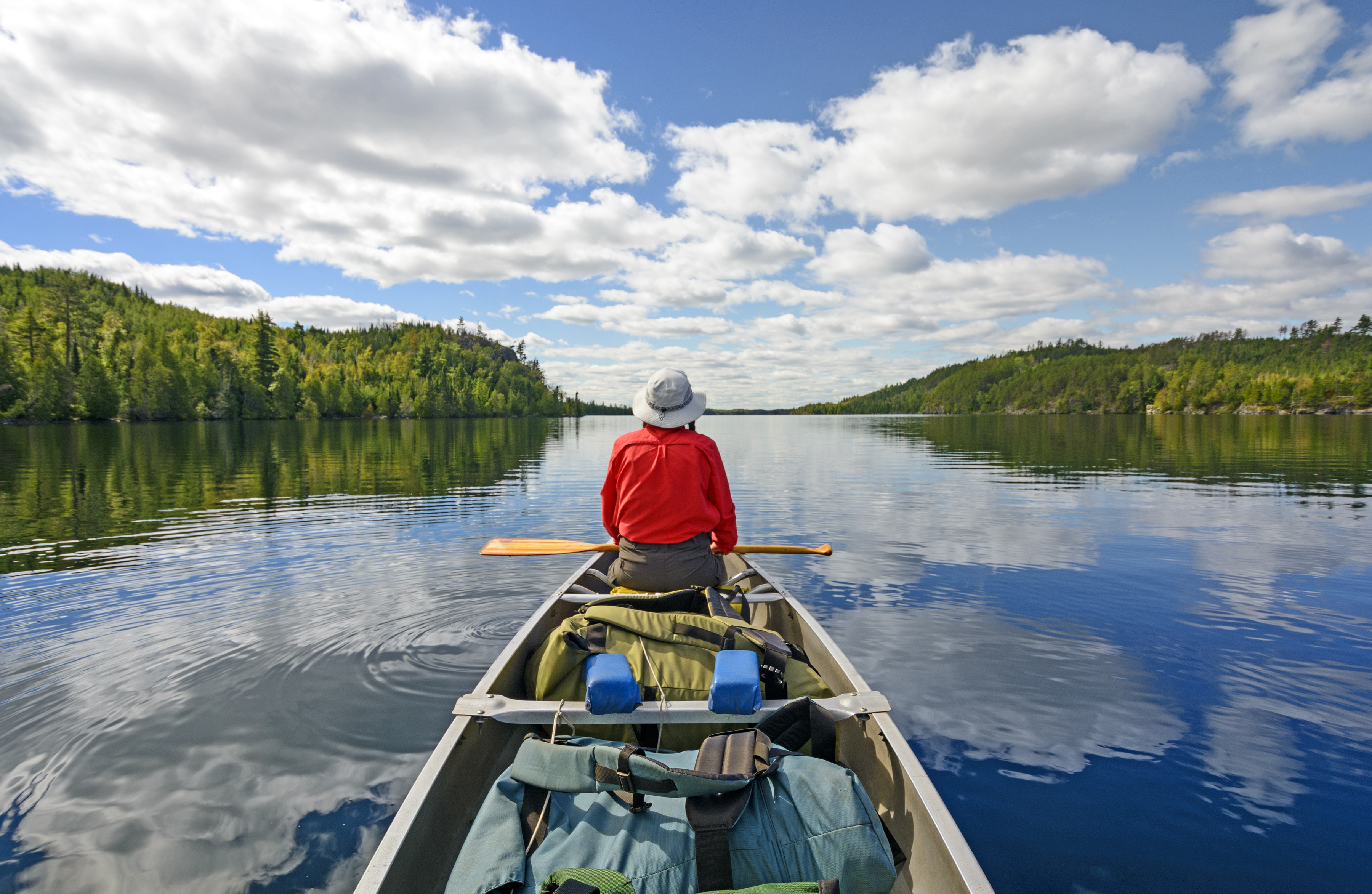
If you’re in the market for a canoe, we’ve put together this buying guide to get you clued up on the key features to look for in your new boat.
Whether this is your first canoe, or you’re upgrading your boat, we answer all your questions to make sure everything goes without a hitch.
Kayak or Canoe: What’s the Difference and What Suits You?
I’m assuming that if you’re reading a canoe buying guide, you’ve at least done a little bit of research and know the difference between kayaks and canoes?
If you don’t, you should check out our article that explains the difference between the two types of boat in detail. But for now, we’ve summed up the main points below.
- Canoes are open vessels that can carry multiple passengers and lots of equipment. They’re highly functional and can be thought of as the pickup trucks of paddling. You use a single blade oar to paddle a canoe.
- Kayaks are closed vessels – although you do get sit-on-top models now - where you sit inside the cockpit. They’re usually smaller and more nimble than canoes, but the downside is that they don’t have as much storage capacity. They’re paddled with a double-bladed paddle.
Sometimes it isn’t obvious which boat is right for you, especially as the traditional characteristics of kayaks can now be found on canoes, and vice versa.
But generally, you would opt for a canoe if you’re going on long expeditions, planning a camping trip with lots of gear, or want to take multiple passengers onboard.
If a canoe ticks all your boxes, here are a few questions to ask yourself before you go dropping $500+ on your new boat.
Pre-purchase Questions for Canoes
Buying the correct tool means one must first understand the job at hand. Similarly, before the purchase of a canoe, it’s crucial to know what type of canoeing you’ll participate in.
The following are a few things to consider:
- Will you be paddling open water such as lakes, or rivers?
- Will you be encountering white-water on your trip?
- Number of seats – how many people need to fit in your canoe?
- Storage space – how much gear will you need to carry (how long will you be out)?
- Do you have any plans for fishing from your canoe?
- What’s your budget?
- Have you considered how you’re going to transport your boat?
Don’t forget to think a few trips ahead, too. It would suck to buy a beautiful new canoe only to find out that a month later, you’ll be paddling an area where it’s necessary to have an entirely different type of boat.
On the other hand, though, no one canoe will be perfect for every type of trip. It’s a balance.
This short video sums up the considerations when choosing your canoe.
What Type of Canoe is Right for You?
There are several broad categories of canoes, each with a different purpose. Here’s a summary of the various types of canoes which will give you a better idea of which one best suits your lifestyle and intentions.
Racing Canoes
These hyper-expensive and ultralight boats are for serious racers. Often made of advanced composite materials, they’re light enough to pick up with a couple of fingers. Not for the weekend warrior.
Budget and Recreational Canoes
These are the larger, bulkier, heavier boats you might see for rent at the local canoe livery. They’re inexpensive comparatively and very durable.
At the budget end of recreational canoes, you won’t find any top-class features or a thoughtful design, but they will allow a fun, family day trip on the water.
Fishing canoes would fall into this category, whether they’re purpose built for fishing, or a recreational canoe that’s had a few tweaks.
You’ll also find inflatable canoes in this section. Inflatable canoes aren’t just a gimmick and are surprisingly sturdy and capable of some rough usage. They’re perfect for beginners who aren’t quite sure if canoeing is for them, or for people who don’t have space for a hard shell canoe.
Expedition Canoes
This category can bleed over into others but, generally, boats in this category have a very purposeful design.
Characterized by high levels of customizable features, often these niche canoes can (or must) be made to order from small manufacturers.
Ranging in size, length, passenger capacity, storage space, and featuring lightweight and advanced materials, these boats can be tailored to the requirements of the trip.
River Canoes
Made for shooting rapids and navigating whitewater, these canoes are agile and durable. Not the best choice for flat water travel or longer trips, but perfect for sneaking through those class IV’s.
If you’re planning to do a substantial amount of paddling on rivers where whitewater is available, you’ll want to pick up one of these specific canoes for your activities.
Canoe Hull Shapes and Why They Matter
The shape of the bottom of a canoe greatly influences its maneuverability and stability. Here are the four hull shapes and their characteristics.
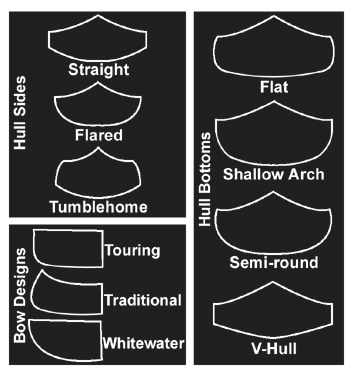
Flat Bottom
Probably the most common hull design, the flat bottom is the local favorite of canoe liveries and rentals the world over.
Flat bottom canoes are extremely stable in calm water and easier to turn. But they’re inefficient due to large amounts of drag, and they quickly lose their maneuverability as soon as they’re weighted down by excessive loads.
Semi-Rounded
Round hull canoes feature an evenly curved bottom which arches from side to side.
These boats, as you might expect from something with a round base, are hard to balance and stabilize at first – like trying to balance on a foam roller.
However, a rounded-bottom canoe can prove much more dependable on rough conditions; which is why more advanced paddlers can have a preference for them.
At speed, these boats demonstrate high efficiency and stability.
Shallow Arch
Shallow arch hulls are halfway between flat bottom hulls and semi-round hulls. For that reason, they display half of the characteristics of each design.
V Shaped Hull
More akin to what you might see on your average bass boat, these canoes feature a pronounced keel. Arguably the best tracking and stability of any boat hull type available.
Combining V-shaped hulls and shallow-arch bottoms yields excellent initial and secondary stability, optimal maneuverability, and good tracking. They’re often regarded as a middle-of-the-road solution for those who want to traverse a quiet river with some rougher sections.
Check out this video from Old Town Canoe for further explanation of how the shape of the hull influences boat performance.
Canoe Size and Dimensions
There are three main factors which affect a canoe’s characteristics and, thus, its best-suited purpose. These are relatively obvious – length from bow to stern, width across the beam, and depth of the sidewalls.
Depth
Measure from the top of the gunwales to the lowest point in the canoe, this is the depth of your canoe. Canoes with higher sidewalls sport great carrying capacity and keep water out much better than shallow canoes.
Canoes with short sidewalls are - pound for pound - lighter than the deeper canoes but come with a drawback. These short sidewalls allow water in much more easily in rough water!
Width and Beam
In boat terms, the beam is the width of your boat at it’s largest point.
Wider boats are heavier, but more stable laterally. They’re much harder to topple and good for beginners who are still finding balancing tricky. These boats are better suited for open water and rough weather.
Narrow beam canoes can cut through the water more effortlessly and conserve your energy better by minimizing drag. That means they’re more agile, but at the expense of reduced stability.
Length
It’s not all about length, that much we do know. But seriously…
There’s a lot of variation in length ranging from the smaller and quicker ten feet vessels, up to the 23-foot, four-person canoes used for long trips. However, most canoes will be in the 16 to 17 foot range.
Longer boats (17+ ft) are usually faster and display great stability and carrying potential once up to speed. Longer boats track better in straight lines and are less prone to varying course due to paddle strokes. These are excellent choices for longer paddle camping trips.
Of course, the downside is that the extra material weighs more, and it takes a bit more grunt to get long canoes off the mark.
Shorter boats (16 ft and under), not surprisingly, are the inverse of long boats. They’re more agile, easier to steer, have quicker acceleration, and can dart into smaller spaces much more easily. They’re also easier to portage and to transport.
Shorter boats are usually recreational or fishing canoes designed for one or two passengers, or river canoes used for whitewater.
Side Geometry
The shape and design of the side of your canoe can be one of three main styles:
- Outwardly flared - greatest stability, harder to paddle
- Inwardly flared – “tumblehome”, less stability, easier to paddle
- Straight – an excellent balance of the two prior designs
Rocker
Just like skis and snowboards, rocker on a canoe refers to the upwardly recurved profile of the boat from bow to stern. Or in laymen's terms, it’s the banana shape of the boat when looking at it side on.
The more curved the hull is, the more rocker the boat is said to have. More rocker equals more agility and efficiency of motion, and you will have an easier time turning canoes with a lot of rocker. You can also handle choppy water better in a boat with high rocker.
The downside to high rocker is that it makes it difficult to keep the boat on a straight line, high wind can influence the boat more, and it makes balancing harder on calm waters.
Entry Line
This is the term which describes the shape of the boat where the front end meets the water. Sharply pointed boats are highly efficient as they slice into the water.
However, they can be prone to diving under waves when compared to their more rounded, blunt counterparts.
A recurved or raked stem, is way better to ride over waves, but it’s much less resistant to side winds and makes the canoe slightly slower.
Materials Construction
You’ll want to consider the weight and durability of your canoe, both of which are factors influenced by the materials it’s made from.
There are a ton of materials out there, many of which are proprietary designs. We’re only going to cover a few of the more common large classes of materials here.
Aluminium
Aluminum is a heavy material, but it also has excellent strength and durability properties. It is becoming less common in canoe design.
Fiberglass
Glass canoes are lighter than their older aluminum counterparts. Fiberglass canoes are reasonably robust and relatively inexpensive to buy or to repair. These canoes can be extremely light!
ABS
ABS is a plastic used in some canoe construction. Many times it is reinforced with other materials and layered to make a superior final product. Often quite heavy!
Carbon Fiber
Carbon fiber, Kevlar, and other future-tech composites are extremely lightweight, making them less draining to paddle. They’re used in advanced canoe construction as they have superb strength to weight ratios and are extremely impact-resistant.
The drawback of a feather light and tough-as-nails canoe? A huge price tag, sometimes in the thousands.
Conclusion
It’s important to keep in mind your ideal paddling trip and conditions. Most beginner canoe enthusiasts do not need a boat which can handle waves and extreme long distance touring. If open water touring is your goal, however, then you may need to think forward a bit.
PRO TIP: Invest in an aftermarket seat addition (or order an upgraded seat from the manufacturer) if you have a sitting canoe (as opposed to kneeling).
Don’t forget to save room in your budget for a comfortable PFD and lightweight paddle.
Further Reading
http://www.paddlinglight.com/articles/how-to-choose-a-canoe/
http://www.outdoorplaces.com/Features/Paddle/pickcanoe/newcanoe1.htm
As an Amazon Associate, we earn from qualifying purchases. This is without any additional costs for the buyer but does support us in maintaining our website.
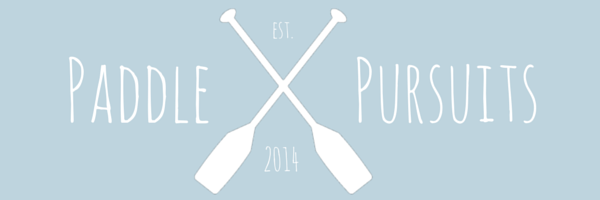
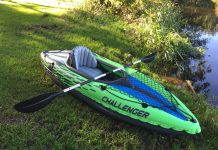
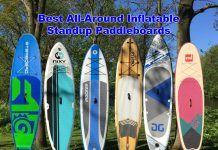
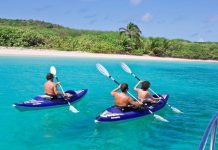
My fiance and I want to go canoeing since our new area has a lot of places to go canoeing on. We have never looked for a canoe before and liked your tip to watch out for the shape and design of the canoe. I think we are leaning towards a 2-person canoe instead of 2 single seaters and appreciated the help!
Hi Alexandria, thanks for your question. If you’re interested in a 2-person canoe you can either opt for a hardshell or inflatable canoe. Both have their advantages and disadvantages. A good hardshell (fishing) canoe is for instance the Sun Dolphin Mackinaw and a very good inflatable canoe is the Sea Eagle 330. I would advise to read through the articles and decide what type of canoe you want to buy and then look for the best in that category. Good luck and have fun paddling!